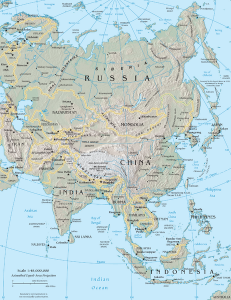Geography of Asia
Asia is the central and eastern part of Eurasia, comprising approximately fifty countries. It has an area, including islands, of roughly 789,694,700 km². Asia is joined to Africa by the Isthmus of Suez and to Europe by a long border generally following the Ural Mountains.
Medieval Europeans considered Asia as a continent, a distinct landmass. The European concept of the three continents in the Old World goes back to classical antiquity with the etymology of the word rooted in the ancient Near and Middle East. The demarcation between Asia and Africa is the isthmus of Suez and the Red Sea. The boundary between Asia and Europe is commonly believed to run through the Dardanelles, the Sea of Marmara, the Bosporus, the Black Sea, the Caucasus Mountains, the Caspian Sea, the Ural River to its source, and the Ural Mountains to the Kara Sea near Kara, Russia. However, modern discovery of the extent of Africa and Asia made this definition rather anachronistic, especially in the case of Asia, which would have several regions that would be considered distin ct landmasses if these criteria were used (for example, South Asia and East Asia).
ct landmasses if these criteria were used (for example, South Asia and East Asia).
Geologists and physical geographers no longer consider Europe and Asia to be separate continents. It is either defined in terms of geological landmasses (physical geography) or tectonic plates (geology). In the former case, Europe is a western peninsula of Eurasia or the Africa-Eurasia landmass. In the latter, Europe and Asia are parts of the Eurasian plate, which excludes the Arabian and Indian tectonic plates.
In human geography, there are two schools of thought. One school follows historical convention and treats Europe and Asia as different continents, categorizing Europe, East Asia (the Orient), South Asia (British India), and the Middle East (Arabia and Persia) as specific regions for more detailed analysis. The other schools equate the word “continent” in terms of geographical region when referring to Europe, and use the term “region” to describe Asia in terms of physical geography. It is becoming increasingly common to substitute the term “region” for “continent” because in linguistic terms, “continent” implies a distinct landmass.
There is much confusion in European languages with the term “Asian”, which almost always refers to a subcategory of people from Asia rather than referring to “Asian” defined in term of “Asia”, because a category implies homogeneity. In American English, Asian refers to East Asians, while in British English, Asian refers to South Asians. Some definitions of Asia exclude Turkey, the Middle East, or Russia. The term is sometimes used more strictly in reference to Asia Pacific, which does not include the Middle East or Russia, but does include islands in the Pacific Ocean — many of which are considered part of Australasia or Oceania. Asia contains the Indian subcontinent, Arabian peninsula, as well as a piece of the North American plate in Siberia.
Asia is a subregion of Eurasia. For further subdivisions based on that term, see North Eurasia and Central Eurasia.
- Central Asia
- Iranian Plateau
- East Asia
- Far East
- North Asia
- South Asia (also Indian subcontinent)
- Southeast Asia
- Southwest Asia (or West Asia)

